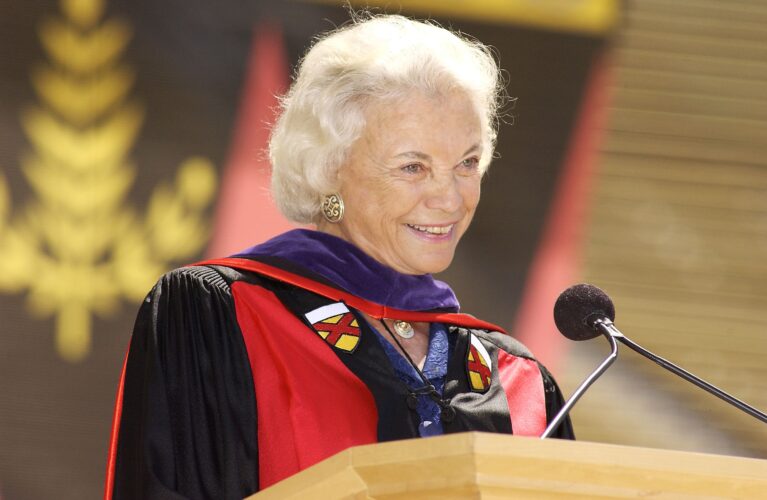Sandra Day O’Connor ’50 LLB ’52, the first woman to serve on the Supreme Court of the United States, passed away on Dec. 1. From her early years at Stanford Law School, to becoming the first woman on the Supreme Court, O’Connor left a legacy wherever she served.
O’Connor was born in 1930 and grew up on a ranch in Texas. Her father inspired her to apply to Stanford.
“My father had wanted to go to Stanford, but he ended up going back to take care of the Lazy B Ranch and never left it,” O’Connor told Stanford Magazine in 2006. “My focus on Stanford undoubtedly came from what he had hoped to do, although neither my dad nor my mother ever told me where to apply.”
At 16 years old, O’Connor began to study economics at Stanford, where she became inspired by Harry Rathbun ’16 ’20 J.D. ’29 to apply to Stanford Law School.
“I took his business law course and thought it was fantastic,” O’Connor said. “I applied to law school for early admission, and to my great surprise they accepted me.”
Through the 3-3 program, she was able to begin her first year of law school while finishing her final year of her undergraduate degree.
During her years at the Law School, she worked as the editor of the Stanford Law Review. Her time at Stanford continued, as she became a member of the Stanford Board of Trustees until 1980.
To honor O’Connor, the Law School celebrates her every Oct. 5 by wearing ribbons and contributing to the library fund, which is used to add books to the library relating to the Supreme Court.
“The Law School was such a joy to me (except possibly during Dead Week). I marveled at the talents of my great professors … I developed some of the closest friends I will ever have,” O’Connor said in an interview with the Stanford Law School in 1981. “Beyond those personal relationships, my opportunities for service as an assistant attorney general, as a state senator and as a judge all flowed from the school you now attend.”
O’Connor said that she liked her time in law school “very much” and gained skills “analyzing problems and issues.” “It was unlike any previous classes or study” she had had before, she said.
The eighth president of Stanford, Donald Kennedy, credited Stanford for its tradition in giving women opportunities to receive an education even during the earlier years.
“We are proud of Sandra O’Connor, whose own accomplishments brought you here, but proud too that we provided an atmosphere and perhaps a set of values that gave her encouragement,” Kennedy said at the reception for O’Connor.
O’Connor was unable to find a job after graduating from Stanford Law School, as hiring a woman was uncommon at the time. She worked as a deputy county attorney in San Mateo, Calif. until 1953, before moving to Germany with her husband, John Jay O’Connor B.A. ’51 LLB ’53. She spent three years in Germany as a civil attorney at Quartermaster Market Center, then later served as a judge at the Arizona Court of Appeals.
In 1981, President Ronald Reagan nominated O’Connor to serve in the Supreme Court. Filling the seat of Justice Potter Stewart, O’Connor became the first woman to serve in the U.S. Supreme Court.
Esther Haelan Ra, a first-year law student, said although many people disagree with O’Connor’s jurisprudential legacy, her reign on the Supreme Court has “an impact for generations to come.”
“As a woman myself, I am grateful for the opportunity to study the law and not only understand its impact on my society, but also bring my perspective to an area of study that has traditionally been voiced by men,” Ra said.
“Although it can be challenging at times to reconcile the societal expectations of womanhood with my studies and dreams regarding the law, Sandra Day O’Connor is a reminder that it remains a hopeful possibility,” she added.
For Dylan Vergara ’26, seeing O’Connor’s portrait at the Supreme Court became a meaningful experience for him as a student at her alma mater who plans to attend law school, even if he doesn’t entirely agree with her politically.
“Breaking barriers at that time was especially important. [Stanford was] one of the exceptions, we had both genders coming to the university, but at the same time the pressure was still on in terms of gender dynamics,” Vergara said. “I think that she broke a lot of glass walls when it came to that.”
Ivy Chen ’26 said she looks up to O’Connor as a pre-law student at Stanford.
“My ultimate goal in life is to serve on the United States Supreme Court, and seeing her as the first female on the Supreme Court is very inspiring to me,” Chen said.
Coming from a background where both her parents were unable to finish school, Chen said that serving on the Supreme Court as a woman seemed difficult for her. But O’Connor serves as an inspiration for her and pre-law students outside of Stanford as well.
“Knowing figures like Sandra Day O’Connor have gone to Stanford Law School, which is so within my reach, it seems really possible and I think that’s the message she’s trying to leave behind,” Chen said. “It is possible to do things, but don’t let your background or the bigger goals or how grand it is set you behind. It’s truly possible.”
